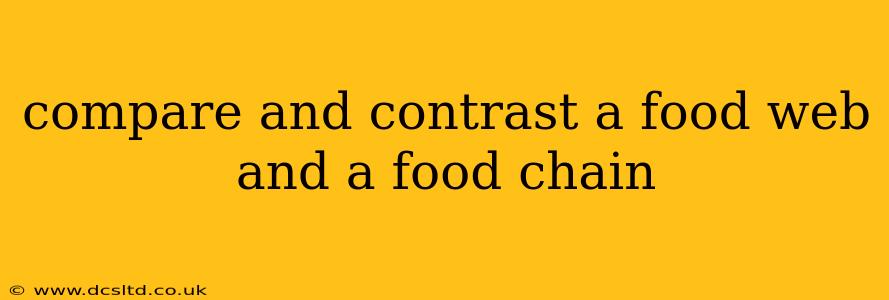Understanding the intricate relationships within an ecosystem requires grasping the concepts of food chains and food webs. While seemingly similar, these two ecological models offer distinct perspectives on how energy and nutrients flow through nature. This article will compare and contrast food chains and food webs, clarifying their differences and highlighting their importance in understanding ecological dynamics.
What is a Food Chain?
A food chain is a linear sequence illustrating the flow of energy and nutrients in an ecosystem. It starts with a producer (usually a plant) that produces its own food through photosynthesis. This producer is then consumed by a primary consumer (herbivore), which in turn is consumed by a secondary consumer (carnivore), and so on. This continues until the top predator, or apex predator, is reached. The chain ends with decomposers (bacteria and fungi), which break down dead organisms, returning essential nutrients to the soil.
Example: Grass → Grasshopper → Frog → Snake → Hawk.
A simple food chain provides a straightforward illustration of energy transfer, but it oversimplifies the complexity of real-world ecosystems.
What is a Food Web?
A food web is a more complex and realistic representation of energy flow within an ecosystem. It depicts the interconnectedness of multiple food chains. Instead of a linear sequence, a food web shows numerous organisms at different trophic levels interacting with each other. An organism can occupy multiple positions within a food web, acting as both predator and prey to different species.
Example: Imagine a food web where grass is eaten by rabbits and grasshoppers. The rabbits are eaten by foxes and eagles, while grasshoppers are eaten by frogs and birds. These predators may also eat each other or other organisms within the system, creating a complex network of interactions.
Comparing Food Chains and Food Webs: Key Differences
| Feature | Food Chain | Food Web |
|---|---|---|
| Structure | Linear sequence | Interconnected network of food chains |
| Complexity | Simple | Complex |
| Realism | Oversimplifies ecosystem interactions | More accurately reflects ecosystem dynamics |
| Number of species | Limited number of species shown | Large number of species represented |
| Energy flow | Shows single pathway of energy transfer | Shows multiple pathways of energy transfer |
| Species roles | Organism plays one role (producer, consumer) | Organism can play multiple roles (predator, prey) |
How are Food Chains and Food Webs Related?
Food webs are essentially collections of interconnected food chains. Each individual food chain within a food web represents a specific pathway of energy transfer. The complexity of a food web arises from the many possible food chains that can exist within a single ecosystem, reflecting the diverse feeding relationships among its organisms.
What are the implications of studying food webs and food chains?
Understanding food chains and food webs is crucial for several reasons:
- Ecosystem stability: The complexity of a food web often contributes to greater ecosystem stability. If one species declines, other species can still thrive due to the multiple food sources available.
- Conservation efforts: Analyzing food webs helps identify keystone species (those having a disproportionately large effect on their ecosystem), which are critical targets for conservation efforts.
- Predicting impacts of change: By studying food webs, scientists can better predict the effects of environmental changes, such as pollution or habitat loss, on an ecosystem.
- Understanding nutrient cycling: Food webs reveal how nutrients are cycled throughout the ecosystem through the transfer of energy and the decomposition of organic matter.
What are the limitations of food web models?
While food webs provide valuable insights, they have limitations:
- Complexity: It is challenging to accurately map all the interactions in a large, complex ecosystem.
- Dynamic nature: Food webs are constantly changing in response to environmental factors and species interactions.
- Indirect effects: The model may not fully capture indirect effects of species interactions or cascading trophic effects.
In summary, while a food chain provides a simplified illustration of energy flow, a food web offers a more comprehensive and accurate picture of the intricate relationships within an ecosystem. Understanding both models is crucial for appreciating the complex interplay of life and the importance of ecological balance.
